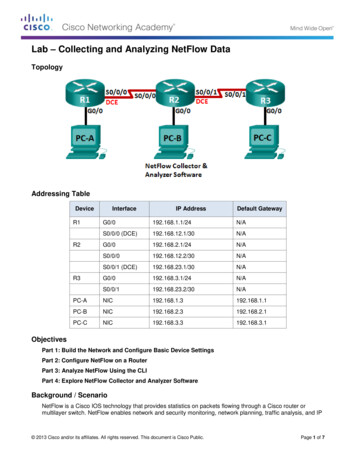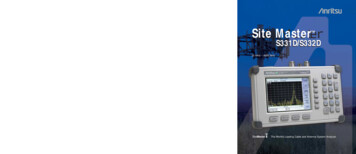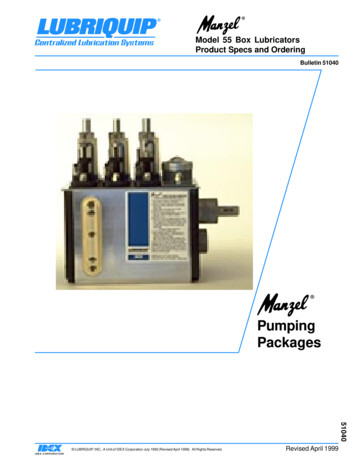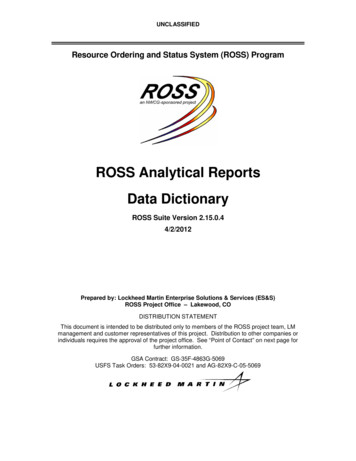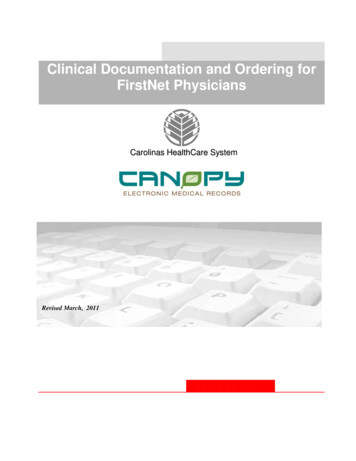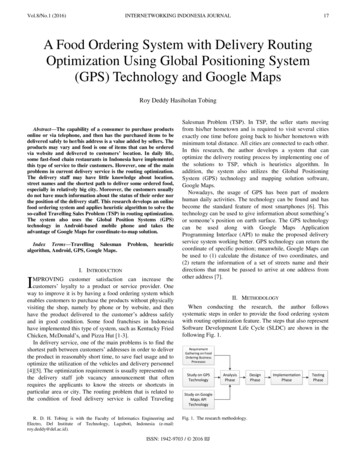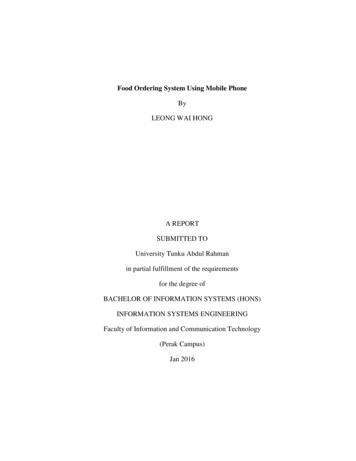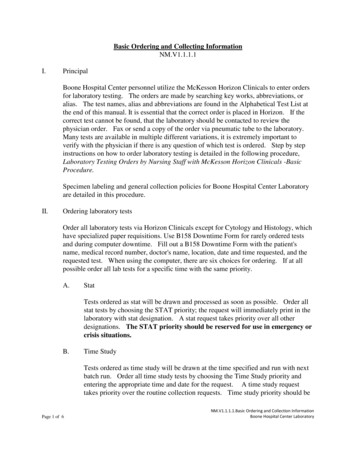
Transcription
Basic Ordering and Collecting InformationNM.V1.1.1.1I.PrincipalBoone Hospital Center personnel utilize the McKesson Horizon Clinicals to enter ordersfor laboratory testing. The orders are made by searching key works, abbreviations, oralias. The test names, alias and abbreviations are found in the Alphabetical Test List atthe end of this manual. It is essential that the correct order is placed in Horizon. If thecorrect test cannot be found, that the laboratory should be contacted to review thephysician order. Fax or send a copy of the order via pneumatic tube to the laboratory.Many tests are available in multiple different variations, it is extremely important toverify with the physician if there is any question of which test is ordered. Step by stepinstructions on how to order laboratory testing is detailed in the following procedure,Laboratory Testing Orders by Nursing Staff with McKesson Horizon Clinicals -BasicProcedure.Specimen labeling and general collection policies for Boone Hospital Center Laboratoryare detailed in this procedure.II.Ordering laboratory testsOrder all laboratory tests via Horizon Clinicals except for Cytology and Histology, whichhave specialized paper requisitions. Use B158 Downtime Form for rarely ordered testsand during computer downtime. Fill out a B158 Downtime Form with the patient'sname, medical record number, doctor's name, location, date and time requested, and therequested test. When using the computer, there are six choices for ordering. If at allpossible order all lab tests for a specific time with the same priority.A.StatTests ordered as stat will be drawn and processed as soon as possible. Order allstat tests by choosing the STAT priority; the request will immediately print in thelaboratory with stat designation. A stat request takes priority over all otherdesignations. The STAT priority should be reserved for use in emergency orcrisis situations.B.Time StudyTests ordered as time study will be drawn at the time specified and run with nextbatch run. Order all time study tests by choosing the Time Study priority andentering the appropriate time and date for the request. A time study requesttakes priority over the routine collection requests. Time study priority should bePage 1 of 6NM.V1.1.1.1.Basic Ordering and Collection InformationBoone Hospital Center Laboratory
reserved for use on those tests that require drawing at a specific time, i.e. druglevels, ABG’s, and tests ordered for specific time intervals. All Microbiologyorders should be TS. When tests are ordered inappropriately as Time Study, theykeep other true time study tests from being drawn on time.C.Nursing Staff Collected (NSGSTF Collect)Order any blood tests that will be drawn by nursing personnel from a line or anyother specimen that will be nurse/tech/RT collected by choosing NSGSTFCOLLECT as the priority. The request will print in the laboratory with a linedraw designation. Once received, the sample will be processed on the next testrun unless stat is noted in the comments.D.Center for Advanced Medicine (CAM BLDG)Patients having laboratory testing drawn in PASS, OPS, Operating Room, CathLab or GI lab should be ordered choosing the CAM BLDG priority. This allowsfor the test orders to print on the laboratory printer in surgical services when thearea is staffed with a lab assistant.E.RoutineTests ordered as routine will be drawn at the laboratory's routine draw timeswhich are 0300, 0500, 0700, 0900, 1100, 1300, 1500, 1700, 1900, 2100 and 2300.Order all routine tests by choosing the Routine priority and entering the correctdate for the test to be performed. The requests will print at the assigned hour orwhen the lab requests them in the laboratory.F.OutpatientPatients, either new admissions or outpatients that present in Admissions forlaboratory testing should be ordered with the Outpatient priority. This assuresthat the laboratory test orders will print in the outpatient drawing area when it isstaffed with a lab assistant.G.Add-on/Back OrderThis priority is made for orders on specimens that have already been drawn andreceived in the laboratory for other testing. The laboratory will not have tore-draw the patient, if the sample is adequate and of the appropriate sample tyPage 2 of 6NM.V1.1.1.1.Basic Ordering and Collection InformationBoone Hospital Center Laboratory
III.Labeling of samplesA.Any specimen sent to the laboratory must be labeled with the following:1.2.3.4.5.6.7.B.IV.Specimen Labeling Errors–If the specimen is missing any of the aboveinformation. The collection personnel will be required to come to the laboratoryto correct the labeling error and sign the Laboratory Specimen Labeling ErrorForm for documentation purposes.Fasting Status–The listing in the Alphabetical Test List at the end of this manual, statesthose tests which have fasting or other dietary requirements. For the following commontests, the patient must be fasting to assure valid test results:A.B.C.D.E.F.V.Patient's full name.Patient's medical record number.Date and time that sample was collected.Initials of the person who collected the sample.NOTE: If Blood Bank required Blood Bank armband number either( sticker if you are banding patient) or # written on the tube if thepatient is already banded. Without this information the specimen will berejected for Blood Bank testing.If specimen is for culture, note source.If specimen is a 24 hour or other timed urine, include start and stop timesand dates.Lipid Profile - 9 to 12 fast.Fasting Glucose, Basic Metabolic Panel or Comprehensive Metabolic PanelAll tolerance tests.Triglycerides - 9 to 12 hour fast.Gastric Analysis/GastrinWhenever requested by an attending physician, any specimen for laboratoryexamination will be drawn from the patient in a fasting state.Transport to Laboratory:A.The pneumatic tube is appropriate transportation for blood, urine, andMicrobiology cultures. Cerebrospinal fluid and other difficult to obtainspecimens should not be sent via pneumatic tube.B.All specimens are considered biohazardous and must be double-bagged beforeputting in pneumatic tube. The inner bag should be a biohazard ziplock bag.Page 3 of 6NM.V1.1.1.1.Basic Ordering and Collection InformationBoone Hospital Center Laboratory
VI.C.Foam is available to cushion specimens and should be used with all blood andurine specimens.D.Any specimen preserved in formalin, B-5 fixative, or Saccommono fixative (greenCytology fixative) should NOT be sent by pneumatic tube.Common Laboratory tests/specimen requirementsThe table at the end of this section provides a quick reference for the majority of commonlaboratory tests. Complete instructions for collection of all laboratory tests eitherperformed at Boone Hospital or sent out to a reference laboratory is included in theBoone Hospital Center Catalog available printed at request or at bhclab.testcatalog.orgVII.Specimen CollectionA.Approved BHC Nursing Resources for Specimen Collection found in thePolicies and Procedures Compliance 360, available on all network computers.1.Specimens-Drawing Capillary Blood from a Heelstick Procedure (Policyand Procedure).2.Specimen Collection: Capillary (Mosby)3.Hemodialysis: Blood Specimen4.Specimen Collection: Stool (Policy and Procedure)5.Cord Blood Sampling (Policy and Procedure)6.Specimen Collection: Radial Artery Puncture of Newborn/Child7.Specimen Collection: Nasopharyngeal Swab (RSV/Influenza/RPP)8.Specimen Collection: Sputum9.Specimen Collection: Tissue Scraping10.Venipuncture (Neonatal) Mosby11.Venipuncture for Blood Sampling: Pediatric (Mosby)12.Blood Specimen Collection: Venipuncture (Nursing)13.Venipuncture: Blood Culture (Mosby)14.Specimen Care and Handling in the OR (Policy and Procedure)15.Venous Blood Sampling (Home Health)16.Specimen Collection: GI Lab Handling of Specimens17.Arterial Catheter Blood Sampling: Closed Blood Conservation Method(Mosby) (Pediatric)B.Page 4 of 6All nursing and ancillary staff must have appropriate training/orientation toperform specimen collections. These are documented during PNO anddepartmental training. Venipuncture, capillary puncture and arterial puncturetraining is performed and documented by laboratory personnel. SpecimenCollection competency for laboratory and respiratory therapy are performedNM.V1.1.1.1.Basic Ordering and Collection InformationBoone Hospital Center Laboratory
annually. Yearly competencies for patient care personnel are performed by thepoint of care coordinator and trainers. Additional training is provided for staff inoutreach locations that collect samples to send to BHC.Page 5 of 6NM.V1.1.1.1.Basic Ordering and Collection InformationBoone Hospital Center Laboratory
Prepared By: Becky Hennessy, MT (ASCP) DLMApproved By:Date: 02/1996Date:New / Revised (Circle :Date:Date:Date:Reviewed:Date:Page 6 of 6NM.V1.1.1.1.Basic Ordering and Collection InformationBoone Hospital Center Laboratory
Laboratory Tube Color Selection GuideCommon tests Sorted AlphabeticallyLaboratory TestABGAmmoniaAnti-XAAPTTBasic Metabolic Profile (BMP)(Na, K, Cl, CO2, Gluc, BUN, Creat)BilirubinBlood CultureBlood Type (ABORH)CaffeineCKMBComplete Blood Count (CBC)(HP and Auto Diff)Complete Metabolic Profile (CMP)(Na, K, CL, GLuc, BUN, Creat, T. Bili, ALk Phos,Albumin, Total Protein, SGOT, Ca)CPKDifferential (Diff)FibrinogenFolateH&H (Hemoglobin & Hematocrit)HemeProfile (HP)Hemoglobin A1CHepatic Function Panel (HFP)(SGOT, SGPT, Alk Phos, Total Bili, Dir. Bili)Hepatitis TestsHomocysteineIonized CalciumLactate (lactic acid)Lipid Profile(Trig, Chol, HDL, Calc LDL)Lipoprotein ALithiumLyme TestsMagnesium (Mg)Mono TestMumpsPre-AlbuminPregnancy TestPro-BNPProcalcitoninPT (Protime INR)PTHRenal Function Panel (RFP)(BMP plus Ca, Phos & Albumin)RubellaRubeolaSedimentation Rate (WSR/ESR)Tobramycin / Vancomycin / GentamicinTroponinTSHType and CrossmatchType and ScreenVitamin B12ZosterTube ColorHeparin Syringe – on ICELavender – on ICE; once filled and disengaged immediately invert 8-9 times to prevent clottingBlue – once filled and disengaged immediately invert 3-4 times to prevent clottingBlue – once filled and disengaged immediately invert 3-4 times to prevent clottingGreen – once filled and disengaged immediately invert 8-9 times to prevent clottingGreen – once filled and disengaged immediately invert 8-9 times to prevent clottingKit from LabPink – plus blood bank arm band on pt, put # on tube; once filled and disengaged immediatelyinvert 8-9 times to prevent clottingGold – once filled and disengaged immediately invert 5-6 times to prevent clottingGreen – once filled and disengaged immediately invert 8-9 times to prevent clottingLavender – once filled and disengaged immediately invert 8-9 times to prevent clottingGreen – once filled and disengaged immediately invert 8-9 times to prevent clottingGreen – once filled and disengaged immediately invert 8-9 times to prevent clottingLavender – once filled and disengaged immediately invert 8-9 times to prevent clottingBlue – once filled and disengaged immediately invert 3-4 times to prevent clottingGold – once filled and disengaged immediately invert 5-6 times to prevent clottingLavender – once filled and disengaged immediately invert 8-9 times to prevent clottingLavender – once filled and disengaged immediately invert 8-9 times to prevent clottingLavender – once filled and disengaged immediately invert 8-9 times to prevent clottingGreen – once filled and disengaged immediately invert 8-9 times to prevent clottingGold – once filled and disengaged immediately invert 5-6 times to prevent clottingGreen – on ICE; once filled and disengaged immediately invert 8-9 times to prevent clottingHeparin Syringe – on ICEABG Syringe – on ICE; or NO GEL Green – on ICE – send immediately to LABGreen – FASTING; once filled and disengaged immediately invert 8-9 times to prevent clottingGold – once filled and disengaged immediately invert 5-6 times to prevent clottingGold – once filled and disengaged immediately invert 5-6 times to prevent clottingGold – once filled and disengaged immediately invert 5-6 times to prevent clottingGreen – once filled and disengaged immediately invert 8-9 times to prevent clottingGold – once filled and disengaged immediately invert 5-6 times to prevent clottingGold – once filled and disengaged immediately invert 5-6 times to prevent clottingGold – once filled and disengaged immediately invert 5-6 times to prevent clottingGold – once filled and disengaged immediately invert 5-6 times to prevent clottingGreen – once filled and disengaged immediately invert 8-9 times to prevent clottingGreen – once filled and disengaged immediately invert 8-9 times to prevent clottingBlue – once filled and disengaged immediately invert 3-4 times to prevent clottingLavender – once filled and disengaged immediately invert 8-9 times to prevent clottingGreen – once filled and disengaged immediately invert 8-9 times to prevent clottingGold – once filled and disengaged immediately invert 5-6 times to prevent clottingGold – once filled and disengaged immediately invert 5-6 times to prevent clottingLavender – once filled and disengaged immediately invert 8-9 times to prevent clottingGreen – once filled and disengaged immediately invert 8-9 times to prevent clottingGreen – once filled and disengaged immediately invert 8-9 times to prevent clottingGreen – once filled and disengaged immediately invert 8-9 times to prevent clottingPink – plus blood bank arm band on pt, put # on tube; once filled and disengaged immediatelyinvert 8-9 times to prevent clottingPink – plus blood bank arm band on pt, put # on tube; once filled and disengaged immediatelyinvert 8-9 times to prevent clottingGold – once filled and disengaged immediately invert 5-6 times to prevent clottingGold – once filled and disengaged immediately invert 5-6 times to prevent clottingCorrect order for drawing tubes: Blue, Gold (or Red), Green, Lavender or PinkFor questions, call extension 3334Revision: December 2014NM.V1.4.1.3. Laboratory Test Tube Color Selection GuideBoone Hospital Laboratory
Patient Identification ProcedureNM.V1.3.2.1I.PrincipleIn a continual, customer-focused, quality improvement environment, the very first stepin correctly performing a specimen collection procedure is to correctly identify thepatient. Assuring the identification of a patient cannot be overemphasized. Aspecimen collected on the wrong patient could result in a prolonged stay in thehospital, medication errors, or even death. Therefore, it is a vital responsibility of allhospital caregivers to check and recheck the patient's armband for their name andhospital number before obtaining any specimen. Verify the HOSPITAL NUMBER ANDTHE NAME; checking the patient's name alone is not sufficient identification. Manytimes patients with the same name are hospitalized in the same institution at the sametime. The following procedure must be followed to assure that specimens arecollected from the correct patient.II.ProcedureA.B.Παγε 1 οφ 4Organize equipment and label for type of collection.1.Bring patientlabels for the number of tubes or containers needed.2.Before you enter the patient's room, have in your hand only those labelspertaining to that patient.Customer Relations--A proper greeting is important to assure accuracy ofinformation. However, it is also an important area of good customer relationswith patients and other BHC employees. Your presentation and your conductdirectly impacts our philosophy that "Boone Hospital Center is a great place towork and a great place to receive health care".1.Identify yourself–If you are their primary caregiver, it is not necessarysince they are familiar with you. If you are not and this is not yourpatient, identify yourself and your capacity.2.State your business--Tell the patient you are there to assist them eitherin a collection or to obtain blood from their line.NM.V1.3.2.1.Patient Identification ProcedureBoone Hospital Center Laboratory
3.Patient's Self Identification--Ask the patient to say their name. NEVERapproach a patient by saying their name; ALWAYS ask the patient to saytheir name to you. If you address the patient with a name, they mayautomatically reply, whether it is their name or not, because they didn'tunderstand or they just want to be agreeable. Also ask the patient’s dateof birth. The patient needs to know that this step is to ensure accuracyin their lab work.Example:4.C."Good morning, my name is . I will be drawingyour blood or collecting a sample this morning for sometests your doctor has ordered. First of all I need to haveyou tell me your full name and your date of birth."When you are finished, be sure to thank the patient, and if appropriate,compliment them on their cooperation. If the patient is a child/infant,make sure to address the parents as well as the patient. A pleasantphlebotomy experience will help ensure that the patient will bereceptive the next time a phlebotomy is necessary. You may be calledupon to collect blood from the same patient numerous times duringtheir hospitalization. Therefore, it is important to develop a goodrapport with each patient.Examine Patient's Armband--DO NOT OMIT THIS STEP--YOU MUST ALWAYSCHECK THE ARMBAND INFORMATION BEFORE DRAWING THE SPECIMEN.1.Whether the patient is cognizant or unresponsive, their name andmedical record number on their armband (ankle band) MUST match thename and number on the lab order labels BEFORE the blood is drawn.Do not rely on grease boards above beds or cards attached to cribs.NOTE: A blood bank armband is not to be used for patientidentification. However, if a patient has a blood bank armband, checkto see if the name matches the hospital armband.2.Παγε 2 οφ 4If there are any discrepancies in any of the information, or, if you haveany doubts as to the patient's correct identification, find the patient'snurse and have the discrepancies corrected before you draw thespecimen. If you are the patient’s nurse, correct the discrepancyimmediately.NM.V1.3.2.1.Patient Identification ProcedureBoone Hospital Center Laboratory
3.If the patient doesn't have an armband-a.4.Παγε 3 οφ 4If you are not the patient’s nurse, identify the patient’s nurse andhave them place the correct patient identification band on thepatient before you collect the specimen. A verbal identificationby the nurse is not adequate.If collecting a sample for Blood Bank, fill out a Blood Bank Card andbracelet (if the patient is not wearing one.) Place the bracelet on thesame arm of the patient as their hospital band. Record the answersconcerning transfusion and pregnancy on the card and send the card tothe laboratory with the specimen. Place one of the numbered stickerson each of the tubes collected.NM.V1.3.2.1.Patient Identification ProcedureBoone Hospital Center Laboratory
Prepared By:DLMApproved By:Becky Hennessy, MT (ASCP)Date: 02/1996Date:New / Revised (Circle :Date:Date:Date:Reviewed:Date:Παγε 4 οφ 4NM.V1.3.2.1.Patient Identification ProcedureBoone Hospital Center Laboratory
Special Instructions for Collection of Specimensby Nursing Personnel for Laboratory TestingNM.V1.3.3.1I.PrincipalThere are several laboratory tests or groups of tests from specific sources or for certainconditions that require extensive instructions on ordering, patient preparation,collection, handling or processing of samples. These instructions are too lengthy to putin the Boone Hospital Center Laboratory Catalog.II.Supplies or EquipmentEach individual procedure will outline if any supplies or equipment is needed.III.ProcedureEach procedure of special instructions is formatted in a style that is similar to BooneHospital Center Nursing Standards. Each specific scenario/test type follows inalphabetical order.
Alcohol, Legal Blood(Drawing Legal Alcohol D
Boone Hospital Center personnel utilize the McKesson Horizon Clinicals to enter orders for laboratory testing. The orders are made by searching key works, abbreviations, or alias. The test names, alias and abbreviations are found in the Alphabetical Test List at the end of this manual. It
